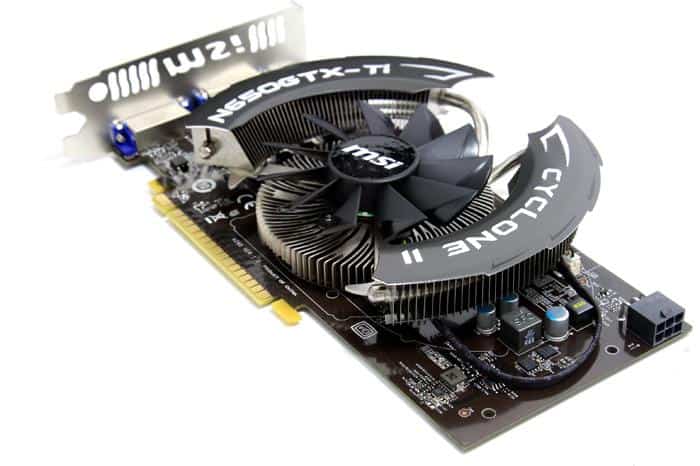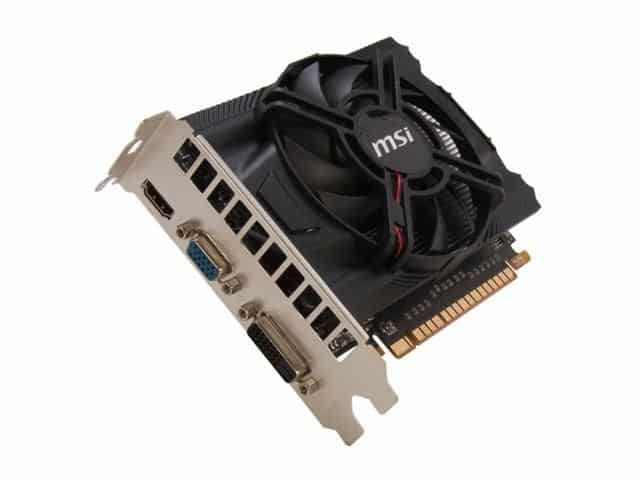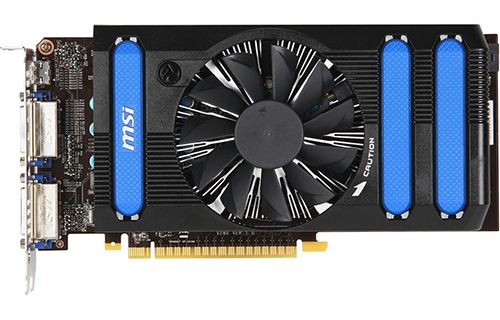amazon MSI GTX 650 reviews
MSI GTX 650 Power Edition
For a Power Edition product, MSI shows the care from the box. Components and features are clearly provided: Triple Over-voltage (GPU-Memory-PLL), Military Class III military components, Dust Removal, Thermal “transformation” …
Card is wrapped in a very thick layer of anti-impact. Included accessories include: manuals, driver disks, a DVI-VGA converter, a miniHDMI-HDMI port and a molex-6pin port. There is also an extra fan box for the ability to “transform”.
This year’s Nouria’s beauty gurus seem to have a serious problem! In addition to three GTX 670 dinosaurs, GTX 680 and GTX 690 luck to escape, all the Kepler card from the GTX 660 Ti back down wearing short circuit board, looking hard to “love”! The new GTX 650 also has the same “height problem”. The GTX 650 PE was designed by MSI to have a longer longer circuit board, so it looks better on the eye.
Using the same heat dissipation as the MSI HD 7750 and HD 7770 Power Edition, the GTX 650 PE does not appear to be the hottest yet. A lot of people lost heart with the two HD 7700 Power Edition before because the blue “look like plastic toys.” In contrast, this greyish color looks cooler and more stale.
The next-generation Power Edition heatsinks use 11-Propeller Blade fans for airflow up to 20% compared to conventional fans, providing more cooling air for the GPU. Behind the rotor is a small blue LED, glowing when the card is active. The annoying point is that the user can not turn off the lights. Due to the benchtable, I was directly exposed to the aching eye.
The unique feature of the next-generation Power Edition cards is the heat dissipation capability. Just drag the top of the heat sink to the top of the card and add a fan, and you’ll find a long-lasting Dual Fan heat dissipation that will not lose any high-end VGA. Or the second option is to add a fan on the main fan to increase the airflow (Double Airflow).
It is because the design of the heat sink is so varied that the card body is quite detailed, not “smooth” as most other graphics cards. The details are very beautiful and reasonable, making MSI more angles.
Unlike the HD 7750 and HD 7770 Power Edition, the GTX 650’s non-Propeller Blade fan is a 9-blade fan on the MSI HD 6850 Power Edition’s Cyclone fan.
For conventional heat sinks, the dust usually forms a thick layer inside the aluminum foil after a period of use. MSI remedies this problem with Dust Removal: In the first 30 seconds after turning on the machine, the reversing fan turns outward at 2100 rpm to blow away the dirt inside the heatsink, Re-sucked in as usual.
On the card does not have the presence of SLI pins, meaning that 2-card mode only uses bandwidth of PCI-Express slot.
On the card is the presence of a 6-pin level. Nvidia recommends that users should be equipped with a power supply of 400W or greater for the GTX 650.
The ports include two DVI ports and a miniHDMI port.
The brown circuit board and plenty of space left me feeling that MSI deliberately pulled the board longer than necessary to increase the aesthetics of the card. In addition, I also saw four waiting positions for memory chips. Most likely they plan to make a GTX 650 or 650 Ti version using this board and have 2 GB of memory.
The GTX 650 has low power consumption so components are not much. Only three phase power supply for the GPU, using MSI’s Military Class III standard components with SFC coils and solid capacitors, ensures maximum stability.
Each phase of the GPU uses two mosfets. In this area I see a waiting position for a 1 phase GPU, besides there are also many mosfet stand positions. It is possible that the GTX 650 Ti Power Edition will use this board and will be equipped with four phase GPUs, three mosfets / phases.
MSI GTX 650 PE uses 4 256 MB Samsung memory chip with K4G20325FD-FC04 code. Recently I was in contact with Hynix and Elpida.
The same is the new Power Edition, but clearly the GTX 650 is much better than the HD 7770. The long bronze heat sink, not a piece like the HD 7770 PE. On the heatsink there are two thermal pads that contact and cool the mosfet. Very few midrange graphics cards in the midrange segment have this thermal pad.
The aluminum foil on the inside looks very solid and compact. The heat from the GPU leads the heatpipe to the aluminum foil and then blows the cool air directly out.
The GTX 650 uses the GPU GK107 – and the GPU with the GT 640. The card was clocked at 1124/1250 MHz by MSI, slightly higher than the Nvidia’s 1058/1250 MHz ref. Memory communication is only 128 bits.
where can you get a MSI GTX 650 online
MSI Computer Corp. NVIDIA GeForce GTX 650 1GB OC GDDR5 2DVI/Mini HDMI PCI-Express Video Card N650-1GD5/OC: Buy it now
MSI NVIDIA GeForce GTX 650 Ti 1GB GDDR5 PCI Express 3.0 Graphics Card N650Ti-1GD5/OC: Buy it now
MSI NVIDIA GeForce GTX 650 Ti Power Edition 1GB GDDR5 OC 2DVI/Mini HDMI PCI-Express Video Card N650TI PE 1GD5/OC: Buy it now
MSI GeForce GTX 650 Ti Graphics Cards N650Ti-1GD5/OCV4: Buy it now
MSI NVIDIA GeForce GTX 650 Ti 1GB GDDR5 VGA/DVI/HDMI PCI-Express Video Card: Buy it now
Overclocking – Temperature – Noise
The room temperature at the test was 29 degrees Celsius. The VGA was tested on a benchtable so the noise could be reduced when applied to the case.
* NOTE: Different graphics cards have different OC capabilities depending on the GPU. The results below are for reference only, the actual may be slightly higher or lower.
The MSI GTX 650 PE supports up to three voltage indicators: the voltage for gpu (core voltage), the voltage for memory and the voltage from the PCI-Express slot (Aux voltage). For the GTX 650 PE card, the program allows for an additional 100 mV core voltage increase, while the memory voltage and auxux voltage are 30 mV.
With MSI’s default Core voltage, the GPU can reach a maximum clock frequency of 1240 MHz. Drag max vcore +100 mV, pulse up a bit to 1300 MHz. I can completely push the extra 20-30 MHz to benchmark for higher scores, but the screen appears green light – a manifestation of power shortage.
Samsung’s memory overclocking is pretty business, can pull up to 1550 MHz. Unfortunately, Max Memory voltage and Aux voltage can not raise the pulse higher.
Like the case of the HD 7770, memory pulses also affect the GTX 650’s performance due to its 128-bit memory bandwidth, but less so. If you intend to overclock the GTX 650, touching the memory pulse is quite necessary. Overclocking performance overclocks performance by 112.9% and 117.6%, respectively, at 1240/1550 MHz and 1300/1550 MHz.
For the part of the heat, the Power Edition radiator completes its mission perfectly:
– 1124/1250 MHz (default): maximum gaming temperature of 52 degrees C, 37% fan ~ 1650 rpm; FurMark temperature 57 degrees Celsius, fan 40% ~ 1830 rpm.
– 1240/1550 MHz (default vcore): 54 degrees Celsius game temperature, 38% fan ~ 1740 rpm; FurMark 59 degrees C, fan 41% ~ 1950 rpm.
– 1300/1550 MHz (vcore +100 mV): gaming 57 degrees C, 43% fan ~ 1830 rpm; FurMark 62 degrees C, fan 43% ~ 2140 rpm.
Noise is also an excellent point of heat dissipation. From a speed of 50% ~ 2400 rpm or less, I did not feel any noise coming out. Up to 55% ~ 2640 rpm starts with a slight breeze. From 65% ~ 3150 rpm or more noise will be annoying. Compared to the above temperatures, the MSI GTX 650 Power Edition is completely silent, giving the player no distraction at all.
Pros:
– Extremely cool
– Beautiful form with cold gray cardboard, long boards.
– Unique heat sink.
– Good components.
– The ability to overclock quite “battle”.
– Features Dust Removal.
Cons:
– Performance not as expected.
– Price is less competitive.
– The blue LED on the fan does not turn off.


